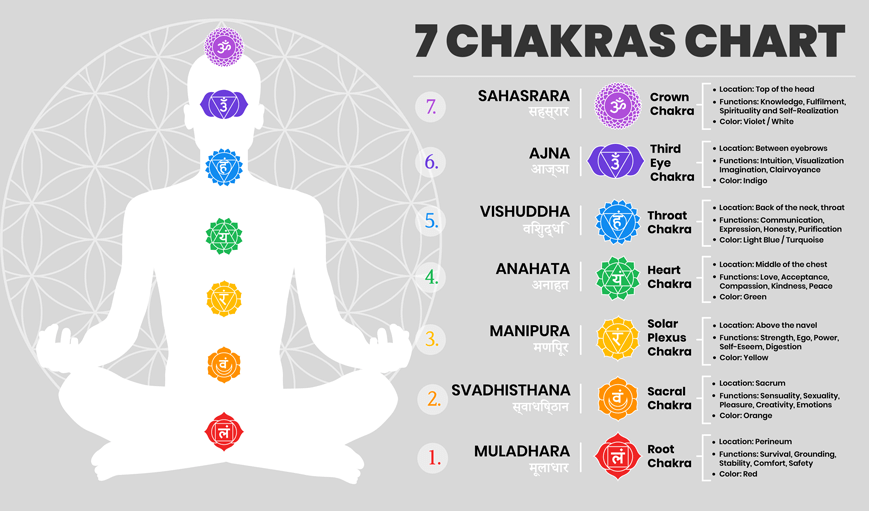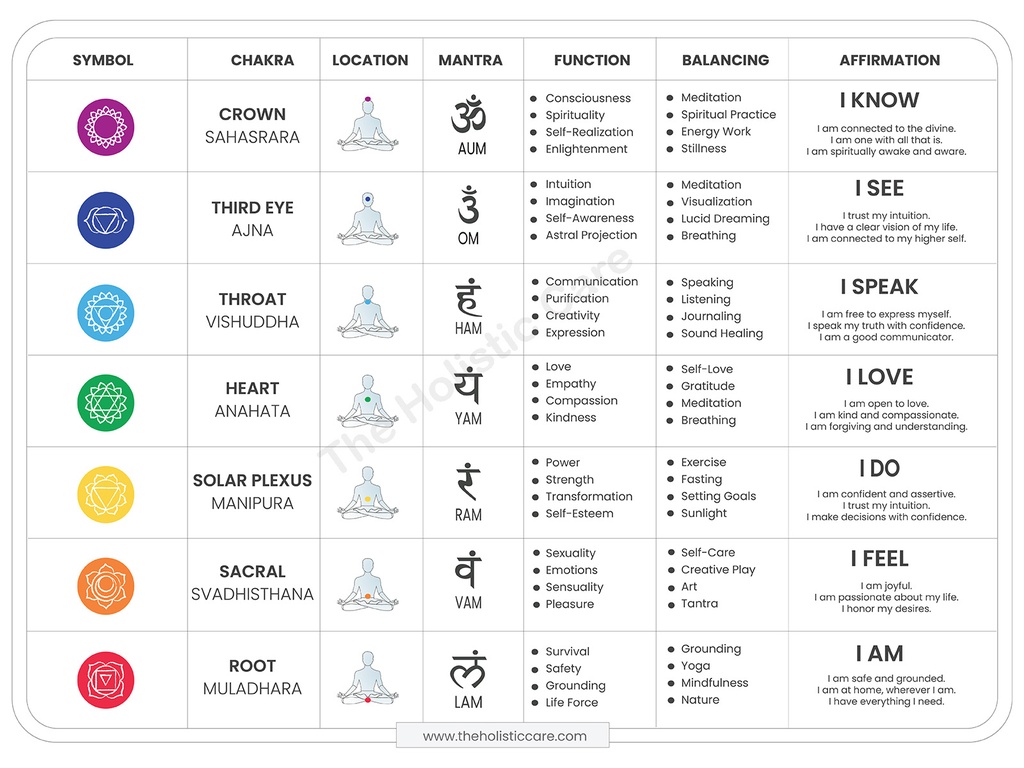The Ultimate Guide to Chakra Charts: Unlock Your Energy Centers
Chakra charts are a vital tool for understanding the seven energy centers in the body. Whether you’re new to chakras or deepening your spiritual practice, a chakra chart visually simplifies the complexities of energy healing, making it easier to identify imbalances and restore harmony.
This guide offers everything you need to know about chakra charts, including their role in balancing chakras, enhancing spiritual awareness, and achieving overall well-being.
What Are Chakra Charts?
Chakra charts are visual representations of the body’s seven major energy centers, each corresponding to specific physical, emotional, and spiritual attributes. These charts typically show:
- Chakra names and locations along the spine.
- Associated colors, symbols, and Sanskrit names.
- Physical and emotional attributes governed by each chakra.

The chart acts as a roadmap for understanding and aligning your energy centers. By identifying blockages through the chart, you can incorporate practices like grounding energy through root chakra healing and exploring sacral chakra healing for emotional balance.
The 7 Chakras and Their Meanings
1. Root Chakra (Muladhara)

- Location: Base of the spine.
- Color: Red.
- Attributes: Stability, grounding, and security.
- Signs of Imbalance: Anxiety, financial insecurity, and disconnection from the physical body.
- Healing Focus: Grounding techniques such as walking barefoot or meditating on stability help heal the root chakra.
2. Sacral Chakra (Svadhisthana)

- Location: Lower abdomen, just below the navel.
- Color: Orange.
- Attributes: Creativity, sexuality, and emotional expression.
- Signs of Imbalance: Creative blocks, difficulty in relationships, or low self-esteem.
- Healing Focus: Sacral chakra healing involves creative activities, water-based therapies, and emotional journaling.
3. Solar Plexus Chakra (Manipura)

- Location: Upper abdomen near the stomach.
- Color: Yellow.
- Attributes: Confidence, personal power, and self-discipline.
- Signs of Imbalance: Digestive issues, low energy, or feelings of helplessness.
- Healing Focus: Breathwork, core-strengthening exercises, and affirmations like “I am strong” nurture this chakra.
4. Heart Chakra (Anahata)

- Location: Center of the chest.
- Color: Green.
- Attributes: Love, compassion, and forgiveness.
- Signs of Imbalance: Resentment, relationship struggles, or lack of self-love.
- Healing Focus: Heart-opening yoga poses and expressing gratitude can balance this energy center.
5. Throat Chakra (Vishuddha)

- Location: Throat.
- Color: Blue.
- Attributes: Communication and self-expression.
- Signs of Imbalance: Difficulty speaking truth, sore throat, or fear of judgment.
- Healing Focus: Singing, chanting, and journaling enhance throat chakra energy.
6. Third Eye Chakra (Ajna)

- Location: Forehead, between the eyebrows.
- Color: Indigo.
- Attributes: Intuition, clarity, and imagination.
- Signs of Imbalance: Overthinking, headaches, or feeling disconnected from intuition.
- Healing Focus: Meditation and visualization practices strengthen third-eye clarity.
7. Crown Chakra (Sahasrara)

- Location: Top of the head.
- Color: Violet or white.
- Attributes: Spiritual connection and enlightenment.
- Signs of Imbalance: Feeling isolated, disconnected, or spiritually stagnant.
- Healing Focus: Meditation, prayer, and mindfulness reconnect you to universal energy.
How Chakra Charts Help Balance Energy
A chakra chart not only identifies areas of imbalance but also guides you toward specific practices to realign each energy center. For example:
- If your root chakra feels blocked, the chart might suggest grounding energy through root chakra healing by connecting with nature or practicing mindfulness.
- An overactive sacral chakra could benefit from meditation focused on self-care and creativity.

Using a chakra chart as part of your daily wellness routine helps maintain energy flow and prevents long-term imbalances.
Tools and Techniques for Chakra Healing
Balancing chakras involves various tools and practices, many of which are directly tied to the insights provided by a chakra chart:
Guided Meditation
Meditations that focus on each chakra’s color and energy can help clear blockages.
Yoga Poses
Specific asanas (poses) target individual chakras. For instance, tree pose (Vrksasana) promotes root chakra stability, while cobra pose (Bhujangasana) stimulates the heart chakra.
Sound Healing
Listening to binaural beats, specific frequencies, or chanting seed mantras (e.g., “Lam” for the root chakra) can help to activate chakra energy.
Crystals and Aromatherapy
Using chakra-specific crystals like amethyst for the crown or carnelian for the sacral chakra enhances healing. Complement this with specific essential oils meant to balance chakras.
Journaling and Visualization
Writing about your emotions or visualizing balanced energy centers fosters healing and clarity.
Benefits of Chakra Charts-Based Healing
- Enhanced Emotional Balance: Chakra charts-based healing provides a holistic approach to addressing emotional imbalances. By identifying and correcting blockages or misalignments within the chakras, individuals can experience a profound shift toward emotional stability.This process encourages resilience in the face of challenges, helping to release stored emotional traumas and reducing stress. As a result, the individual may feel more grounded, centered, and at peace, with an increased ability to respond to life’s ups and downs in a calm and composed manner.
- Improved Physical Health: Each chakra is directly connected to specific parts of the body, influencing its physical function. When these energy centers are out of balance, it can manifest in physical symptoms or health issues related to the area each chakra governs. For example, a blocked root chakra may lead to issues with the lower back, legs, or immune system, while a misaligned heart chakra could affect the heart or lungs.Realigning the chakras helps restore balance, promoting overall physical well-being. As energy flows freely through the body, individuals may notice a reduction in chronic pain, improved organ function, and enhanced vitality.
- Greater Spiritual Awareness: Chakra charts-based healing also enhances spiritual awareness by clearing energetic blockages that may prevent the free flow of spiritual energy. A balanced chakra system fosters a deeper connection to oneself and the universe. With each chakra aligned, you may experience heightened intuition, a stronger sense of purpose, and a more profound understanding of your spiritual path. This renewed sense of awareness often leads to greater clarity, inner peace, and a more harmonious relationship with the world around you.As you reconnect with your higher self, you may find that your spiritual practices become more fulfilling, and your connection to the universe becomes more evident and meaningful.In summary, chakra charts-based healing serves as a powerful tool to bring balance to emotional, physical, and spiritual well-being. By addressing each chakra individually, this holistic approach helps to create a harmonious flow of energy, leading to a healthier, more balanced life.
Quick Tips for Chakra Balancing
- Start your day by consulting a chakra chart and focusing on areas that need attention.
- Practice daily affirmations that align with your chakras, like “I am safe and grounded” for the root or “I trust my intuition” for the third eye.
- Incorporate grounding exercises into your routine to maintain root chakra stability.
Final Thoughts
A chakra chart is more than just a visual tool; it’s a transformative guide to unlocking your full energetic potential. By understanding the chart and integrating practices like balancing chakras, grounding energy, and sacral chakra healing, you can achieve holistic well-being and spiritual growth.
Whether you’re a beginner or a seasoned energy healer, using a chakra chart is the first step toward aligning your mind, body, and spirit. Start your journey today and experience the profound benefits of living in energetic harmony.
Check out our Youtube channel and listen to our free Binaural Beats tracks!


